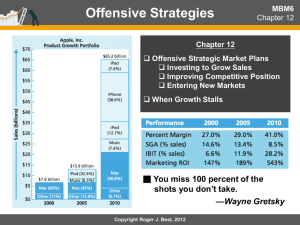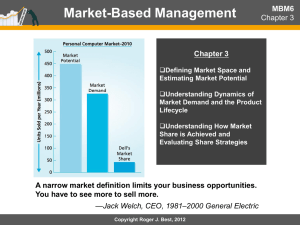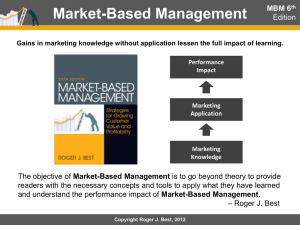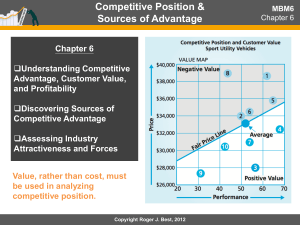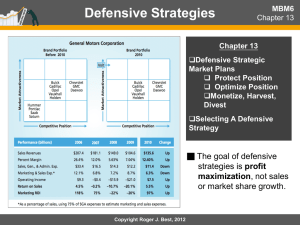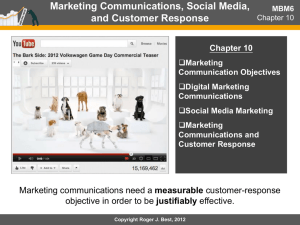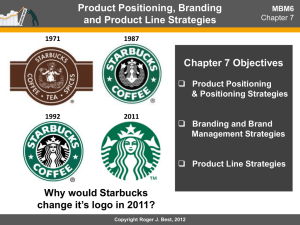MBM6
advertisement
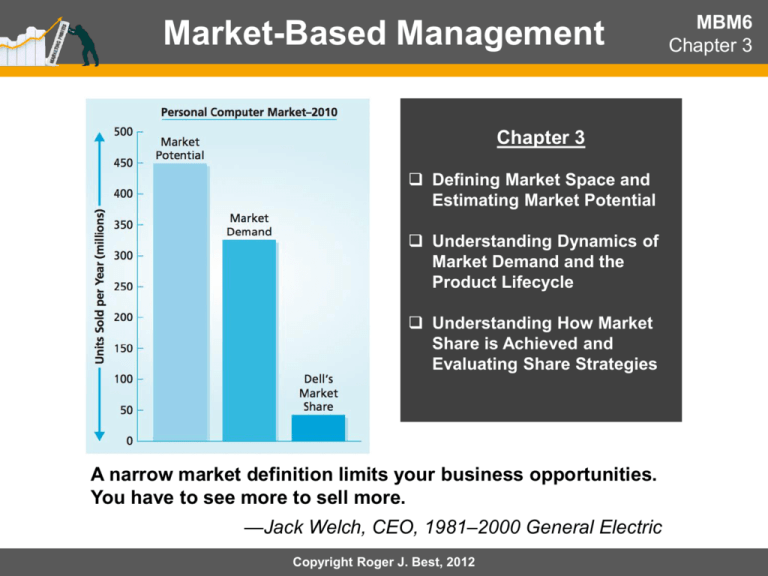
Market-Based Management Chapter 3 Defining Market Space and Estimating Market Potential Understanding Dynamics of Market Demand and the Product Lifecycle Understanding How Market Share is Achieved and Evaluating Share Strategies A narrow market definition limits your business opportunities. You have to see more to sell more. —Jack Welch, CEO, 1981–2000 General Electric Copyright Roger J. Best, 2012 MBM6 Chapter 3 Customer Focus, Customer Performance, and Profit Impact MBM6 Chapter 3 Defining Market Space and Estimating Market Potential In this section we will look at how the greatest threat to a business’s survival—and a major cause of missed market opportunities—is a narrow focus on existing product-markets. Copyright Roger J. Best, 2012 Product-Market Structure MBM6 Chapter 3 Forty years ago, several of these products did not exist, while others had not yet reached their tipping point. Copyright Roger J. Best, 2012 Market Definitions MBM6 Chapter 3 A broad market definition is essential for any business in order to understand and measure market demand, market potential, and market share. A narrow market definition, one adopted by design, is not always a limitation. Copyright Roger J. Best, 2012 Personal Computer Market Demand MBM6 Chapter 3 Knowing the maximum number of units that can be consumed by the defined market is of great strategic importance to a business: After a market reaches its full potential and saturates, new customers will be hard to find. Copyright Roger J. Best, 2012 Estimating Market Potential - PCs Marketing MBM6 Performance Tool 3.1 3 Chapter The first step is to define the geographical boundaries and the consuming units. The consuming units could be defined in terms of individuals, families, households, businesses, or other purchasing entities. Copyright Roger J. Best, 2012 Innovation and Market Potential MBM6 Chapter 3 New technology application essentially goes unnoticed until it reaches a tipping point, then develops more rapidly through continuous innovation. In order for the market to develop further, there must be a disruptive innovation or a discontinuous innovation. Copyright Roger J. Best, 2012 Market Development and Potential MBM6 Chapter 3 Each of these products had a well-defined tipping point, followed by periods of rapid growth and eventually a leveling-off period as market demand approached its market potential. Copyright Roger J. Best, 2012 Customer Focus, Customer Performance, and Profit Impact MBM6 Chapter 3 Understanding Dynamics of Market Demand Throughout the Product Lifecycle In this section we will look at how understanding market demand over time is an important aspect of market planning and strategy development. Copyright Roger J. Best, 2012 Factors of Market Development MBM6 Chapter 3 Many new markets and most global markets are well below their market potentials because large numbers of potential customers have not yet entered them. Copyright Roger J. Best, 2012 Forces that Shape Market Growth MBM6 Chapter 3 Developing and delivering a complete solution requires more than improving the product and making it affordable to the mainstream market. Copyright Roger J. Best, 2012 Forces Driving Market Growth Products or services with weak overall scores for both customer forces and product forces experience very slow market growth. The best results naturally occur when both the customer forces and the product forces are strong overall. Copyright Roger J. Best, 2012 MBM6 Chapter 3 Product-Market vs. Product Life Cycle MBM6 Chapter 3 As the personal computer market has grown, along with the demand for greater speed and capacity, Intel has gone through entire product life cycles for several products, as the graph illustrates. Copyright Roger J. Best, 2012 Product Life Cycle, Market Demand, and Profits MBM6 Chapter 3 In the early stages of the product life cycle the net marketing contribution (NMC) is negative. As the product moves through the lifecycle, NMC will reach break-even, grow, peak, flatten, and begin to decline as market demand decreases. Copyright Roger J. Best, 2012 Average Selling Price MBM6 Chapter 3 One of the reasons that demand grows as a product moves through the growth stages is an ongoing decline in the average selling price of the product. Copyright Roger J. Best, 2012 Estimating Product Life-Cycle Demand and Sales MBM6 Chapter 3 Recognizing that volumes grow and prices decline in the growth stages of the product life cycle, we can estimate future market demand and the MDI by projecting the assumed market growth rate over a 3-year planning period. Copyright Roger J. Best, 2012 Estimating Growth for Market Demand and Sales MBM6 Chapter 3 One of the benefits of estimating market potential is the ceiling it places on market demand. Businesses that have enjoyed years of growth will often project continued growth beyond the market potential. Copyright Roger J. Best, 2012 Life-Cycle Demand, Margins, and Marketing and Sales Expenses MBM6 Chapter 3 Volume grows while the average price declines over the product life cycle Prices tend to decrease faster than unit costs decrease Margins per unit tend to decline over the product life cycle MSE increase over the introductory and early growth phases of the product life cycle MSE as a percentage of sales tend to level off as a product approaches the maturity stage, and they decrease during the decline stage Copyright Roger J. Best, 2012 PC Life-Cycle Sales and Gross Profit Profits can vary over the product life cycle. For PCs, we see continued growth beyond the late growth stage in both sales revenues and market demand in units. Slower growth in volume and declining prices will contribute to lower margins and lower industry gross profits. This modest decline occurs as the PC market moves from late growth to the maturity stage. Copyright Roger J. Best, 2012 Marketing MBM6 Performance Tool 3.3 3 Chapter Customer Focus, Customer Performance, and Profit Impact MBM6 Chapter 3 Understanding How Market Share is Achieved and Evaluating Share Strategies In this section we will look at how, for a given market and the market’s potential for development, a business can determine its best opportunities for sales growth, depending on its potential to grow share. Copyright Roger J. Best, 2012 Market Share Performance Tree Marketing MBM6 Performance Tool 3.2 3 Chapter Moving from bottom to top, each stage of the market share performance tree indicates how the customer response to a strategy influences market share. The first step is to identify the sequence of events that have to take place for a customer purchase to occur. Copyright Roger J. Best, 2012 Market Share Index vs Actual MBM6 Chapter 3 Benefits of MSI: Helps identify the major causes of lost market share opportunity Provides a mechanism for assessing market share change when improvement efforts are directed to an area of poor performance Enables a business to estimate a reasonable potential for its market share Copyright Roger J. Best, 2012 Market Share Potential Index MBM6 Chapter 3 Establishing a desired level of response at each level of the performance tree provides a basis for estimating market share potential. For each level of the tree, the share performance gap indicates the extent of lost market share due to the lower customer response rates. Copyright Roger J. Best, 2012 MDI vs SDI MBM6 Chapter 3 By combining the Market Development Index (MDI) with the Share Development Index (SDI), a business can discover whether they should focus on market development or share development or both, depending on the product’s position in the growth opportunity portfolio. Copyright Roger J. Best, 2012 Using Market and Share Metrics to Build Sales Forecast Marketing MBM6 Performance Tool 3.4 3 Chapter Adding the MDI and SDI to a sales forecast provides a way to understand the potential for future sales growth. Above we see that there is plenty of market growth beyond year 3 of the sales forecast. Copyright Roger J. Best, 2012

